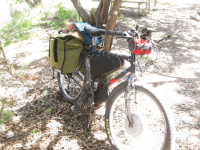flyingbeekeeper
10 W
I've got an old 600W Wilderness Energy kit motor (AOTEMA) that I put into a bike. It ran fine for a few years but then I tweeked the bike this year.
Designed for 36V SLA, I bumped the voltage up to 48V LiFePo. Modded the controller to put out signal to a Cycle Analyst.
I've been doing some long multi day rides with it. I've put 1000 miles on this motor and know I need a little more oopf on hills, some I can't climb all out 30A and peddling hard. I live in Texas hill country, and these hills have some nasty gradients...like 20% in some places. So I want more hill-climbing power, but I don't know what the equivalent of my current brushed motor is in brushless terms. I'd hate to buy a new motor that has less hill-climbing power than my current one.
At this point, basic math says I have a (48/36)600 = 800 W hub motor. So what is the equivalent motor in Brushless? Just to get a ballpark idea of where to start so I can get a little more torque.
Designed for 36V SLA, I bumped the voltage up to 48V LiFePo. Modded the controller to put out signal to a Cycle Analyst.
I've been doing some long multi day rides with it. I've put 1000 miles on this motor and know I need a little more oopf on hills, some I can't climb all out 30A and peddling hard. I live in Texas hill country, and these hills have some nasty gradients...like 20% in some places. So I want more hill-climbing power, but I don't know what the equivalent of my current brushed motor is in brushless terms. I'd hate to buy a new motor that has less hill-climbing power than my current one.
At this point, basic math says I have a (48/36)600 = 800 W hub motor. So what is the equivalent motor in Brushless? Just to get a ballpark idea of where to start so I can get a little more torque.


